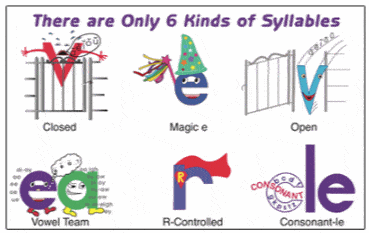
Learning to read can be tough. Words that we read naturally may not come to our kids quite so easily.
At school, teachers help kids with decoding strategies to help students learn to read.
We thought we’d share the six syllable types with you, so that when you are reading with your kids at home, you can help them with decoding words as well.
The six syllable types
There are six hard and fast rules for syllable types – basically how vowel sounds are pronounced. Is there a short a or a long a in ‘water’ – for example.
However, as with any rules in English, there are exceptions to the rules.
Below we’ll go through the six syllable types and highlight the exceptions as part of each category. Let’s dive in.
As a point of reference, V = Vowel and C = Consonant.
1. Closed (VC) Syllables
In closed (VC) syllables the syllables end with a consonant and the vowel is usually short.
For example: f-an or l-eft.
This pattern is the most common.
There are 12 variations:
CVC – as in top
CVCC – as in part
CCVCC – as in fresh
CCVC – as in stop
CVCCC – as in match
CVCCe – as in judge
CCVCCC – as in clutch
CCVCCe – as in grudge
CCCVCC – as in script
VCC – as in add
VC – as in on
VCCC – as in inch
Notice how all the vowels are short vowels.
5 exceptions to this rule – the glued/welded sounds. Those are: all, am, an, ang, ing, ong, ung, ank, ink, onk, unk.
For example: pink, song, sunk.
2. Silent e (VCe)
The silent e (VCe) syllable contains a silent e at the end that makes the vowel sound a long one.
For example, if you add the e to the word mat, you get mate.
Notice how the e at the end is silent, but changes to vowel sound to the long a.
There are 4 variations of (VCe):
CVCe – as in mate
CCVCe – as in shake
CCCVCe – as in strike
VCe – as in ate
3. Open syllable (CV)
The open syllable CV ends with one vowel which will be long. When a syllable is open, it will end with a long vowel sound spelled with one vowel letter; there will be no consonant to close it and protect the vowel.
Therefore, when syllables are combined, there will be no doubled consonant between an open syllable and one that follows.
For example: pa-per, tu-lip, la-zy, si-lent.
There are also a few single-syllable words that are also open syllables: me, she, he, we and no, go, so.
4. r-controlled syllable (Vr)
In r-controlled syllables the vowel sound is changed when followed by r (er, ir, ur, ar, or).
For example: farm-er, m-irr-or, w-orth.
5. Vowel pair (VV)
The vowel pair syllable has a combination of two vowels together that make one sound.For example: m-ai-n, st-ay.
There are 12 variations:
CVVC – as in meat
CCVVC – as in treat
CVVCC – as in teach
CVV – as in ray
CCVV – as in tray
CVVCe – as in leave
CCVVCC – as in bleach
CCVVCe – as in freeze
CCCVVC – as in strain
VVC – as in eat
VVCC – as in each
CCCVV – as in three
6. Consonant le syllable (Cle)
Also known as the stable final syllable, C-le combinations are found only at the ends of words.
If a C-le syllable is combined with an open syllable — as in ca-ble, bu-gle, or ti-tle — there is no doubled consonant. Hence to long vowel sound.
If one is combined with a closed syllable — as in dab-ble, top-ple, or lit-tle — a double consonant results. Hence the short vowel sound.

